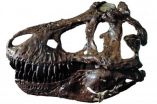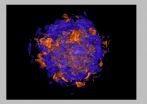(Press-News.org) People who have used cocaine run a great risk of becoming addicted, even after long drug-free periods. Now researchers at Linköping University and their colleagues can point to a specific molecule in the brain as a possible target for treatment to prevent relapses.
Drugs are addictive because they "hijack" the brain's reward system, which is actually intended to make it pleasurable to eat and have sex, behaviors that are necessary for survival and reproduction.
This "hijacking" is extremely long-lived and often leads to relapses into abuse, especially when the individual is exposed to stimuli in the surroundings that are associated with the drug. In an article in the prestigious Journal of Neuroscience the research team can now show that a receptor for the signal substance glutamate (mGluR5), in a part of the brain called the striatum, plays a major role in relapses.
The study, led by David Engblom, associate professor of neurobiology at Linköping University in Sweden, looks at what happens in individuals who lack the glutamate receptor. The experiments were performed on mice that were taught to ingest cocaine.
"Our findings show that the mice who lacked the receptor were less prone to relapse. This is due the fact that their reaction to reward had not been etched into their memories in the same ways as in normal mice. The receptor seems to be a prerequisite for objects or environments that were previously associated with taking drugs, or something else rewarding, to create a craving," says David Engblom.
He hopes that these findings and other studies of mechanisms underlying drug addiction can lead to forms of treatment based on what goes wrong in the brain of an addict.
INFORMATION:
Article: Incentive learning underlying cocaine-seeking requires mGluR5 receptors located on dopamine D1 receptor-expressing neurons by M. Novak, B. Halbout, E.C. O´Connor, J. Rordriguez Parkitna, T. Su, M, Chai, H.S. Crombag, A. Bilbao, R. Spanagel, D.N. Stephens, G. Schütz och D. Engblom.
The Journal of Neuroscience, September 8, 2010, 30(36):11973-11982; doi:10.1523/JNEUROSCI.2550-10.2010
Why the craving for cocaine won't go away
Now researchers at Linkoping University in Sweden and their colleagues can point to a specific molecule in the brain as a possible target for treatment to prevent relapses
2010-09-16
ELSE PRESS RELEASES FROM THIS DATE:
Technology to screen for synbio abuses lags
2010-09-16
London, UK (September 16, 2010) – Amid growing concern that synthetic life sciences pose biosecurity and biosafety risks, scrutiny is increasing into the burgeoning DNA sequence trade. Research published today in the Bulletin of the Atomic Scientists, published by SAGE, looks at the necessity of a global regulator for DNA trade, and the significant barriers to creating one.
Synthetic life sciences are making breakthroughs at a breakneck pace, and could offer technological fixes for our future ecological, technological, and biomedical challenges. But these benefits also ...
The biggest crash on Earth
2010-09-16
During the collision of India with the Eurasian continent, the Indian plate is pushed about 500 kilometers under Tibet, reaching a depth of 250 kilometers. The result of this largest collision in the world is the world's highest mountain range, but the tsunami in the Indian Ocean from 2004 was also created by earthquakes generated by this collision. The clash of the two continents is very complex, the Indian plate, for example, is compressed where it collides with the very rigid plate of the Tarim Basin at the north-western edge of Tibet. On the eastern edge of Tibet, the ...
Goddess of fortune found in Sussita
2010-09-16
A wall painting (fresco) of Tyche, the Greek goddess of fortune, was exposed during the 11th season of excavation at the Sussita site, on the east shore of the Sea of Galilee, which was conducted by researchers of the University of Haifa. Another female figure was found during this season, of a maenad, one of the companions of the wine god Dionysus.
"It is interesting to see that although the private residence in which two goddesses were found was in existence during the Byzantine period, when Christianity negated and eradicated idolatrous cults, one can still find clear ...
Cardiac imaging breakthrough developed at the University of Western Ontario
2010-09-16
VIDEO:
New imaging technique developed by cardiologist, Dr. James A. White and colleagues at The University of Western Ontario shows 3-D image of the heart vasculature and myocardial scar tissue.
Click here for more information.
Cardiologists and surgeons may soon have a new tool to improve outcomes for patients requiring pacemakers, bypass surgery or angioplasties. Research led by Dr. James White and his colleagues at The University of Western Ontario has led to a new imaging ...
Discovery of key pathway interaction may lead to therapies that aid brain growth and repair
2010-09-16
WASHINGTON, DC—Researchers at the Center for Neuroscience Research at Children's National Medical Center have discovered that the two major types of signaling pathways activated during brain cell development—the epidermal growth factor receptor pathway and the Notch pathway—operate together to determine how many and which types of brain cells are created during growth and repair in developing and adult brains. This knowledge may help scientists design new ways to induce the brain to repair itself when these signals are interrupted, and indicate a need for further research ...
NASA's 3-D look into Hurricane Igor's heavy rainfall
2010-09-16
NASA's Tropical Rainfall Measuring Mission (TRMM) satellite has provided a 3-D look at the power "under the hood" (of clouds) in powerful Category 4 Hurricane Igor as it heads toward Bermuda. In the meantime, Igor is creating dangerous surf in the eastern Atlantic, and it will affect the U.S. East coast later today. Igor is an extremely dangerous category four hurricane on the Saffir-Simpson hurricane wind scale today, Sept. 16, and he is expected to remain a large and powerful hurricane over the next several days.
The TRMM satellite, operated by NASA and the Japanese ...
Scientific understanding of T. rex revised by a decade of new research and discovery
2010-09-16
We've all heard this story: the Late Cretaceous of Asia and North America—about 65 million years ago—was dominated by several large-headed, bipedal predatory dinosaurs like Tyrannosaurus rex and Tarbosaurus that had tiny arms. But a decade of new fossil discoveries that have more than doubled the number of known tyrannosaur species has changed this tale. Older and smaller tyrannosaurs have made the evolutionary tree of this group richer and more complex. Furthermore, a series of innovative research projects on topics like bone growth and biomechanics have added an enormous ...
Beating blood clots: Reducing your risk before hip replacement surgery
2010-09-16
Risk factors for venous thromboembolism after total hip replacement (THR) surgery were identified in a new study published in the September 2010 issue of The Journal of Bone and Joint Surgery (JBJS). While the rate of thromboembolism has been significantly reduced through medication, understanding the risk factors could further reduce the likelihood of patients developing this potentially fatal complication.
Two of the most common manifestations of a thromboembolism include:
Deep vein thrombosis (DVT), in which the blood clot forms in a deep vein, commonly in the thigh ...
Placebo effect significantly improves women's sexual satisfaction, study shows
2010-09-16
AUSTIN, Texas — Many women with low sex drives reported greater sexual satisfaction after taking a placebo, according to new psychology research from The University of Texas at Austin and Baylor College of Medicine.
The study was conducted by Cindy Meston, a clinical psychology professor at The University of Texas at Austin, and Andrea Bradford, a 2009 University of Texas at Austin graduate and postdoctoral fellow in the Department of Family and Community Medicine at Baylor College of Medicine. They found that opening a new line of communication about sex can have a positive ...
3-D computer simulations help envision supernovae explosions
2010-09-16
For scientists, supernovae are true superstars -- massive explosions of huge, dying stars that shine light on the shape and fate of the universe.
For a brief burst of time, supernovae can radiate more energy than the sun will emit in its lifetime. With the potential energy of 25 hundred trillion trillion nuclear weapons, they can outshine entire galaxies, producing some of the biggest explosions ever seen, and helping track distances across the cosmos.
Now, a Princeton-led team has found a way to make computer simulations of supernovae exploding in three dimensions, ...
LAST 30 PRESS RELEASES:
Bis-pseudoindoxyls: a new class of single benzene-based fluorophores for bioimaging applications
Blocking a cancer-related pathway helps reduce spine deformities due to genetic disorder, finds new study
New study explores therapeutic potential of CRISPRCas3 genome-editing system
Korea University researchers revive an abandoned depression drug target using structurally novel NK1 receptor inhibitors
Jeonbuk National University researchers highlight advancements in chemical looping fluidized bed reactors
Tyrannosaurus rex grew up slowly: New study reveals the “king of dinosaurs” kept growing until age 40
Commercial water dispenser machines may contain more contamination than tap water
Death and doctors: New WSU study looks at medical student education on end-of-life care
The best hydrogen for heavy-duty transport is locally produced and green
Pregnancy-related high blood pressure varied among Asian, Pacific Islander subgroups
Measuring movement creates new way to map indoor air pollution
Europe’s crop droughts to get worse even as rain increases
New study identifies signature in blood to better predict type 2 diabetes risk
Research spotlight: developing “smart” nanoparticles to deliver targeted gene therapy in osteoarthritis
A CRISPR fingerprint of pathogenic C. auris fungi
Time warp: How marketers express time can affect what consumers buy
CBD treatment reverses key effects of fetal alcohol spectrum disorder in a mouse model
Blood sugar spikes linked to higher risk of Alzheimer's disease
Staying single for longer affects young people’s well-being
New method allows scientists to 3D-print structures within cells
Screening tool helps identify brain-related comorbidities in individuals with Duchenne muscular dystrophy
How do the active ingredients of monkfruit affect health?
News language and social networks: how do they affect the spread of immigration attitudes?
Researchers discover trigger of tendon disease
Your pet's flea treatment could be destroying the planet
Diabetes risk not associated with timing or type of menopause
Bulk inorganic crystals grown from water emit “handed” light
A new AI-based attack framework advances multi-agent reinforcement learning by amplifying vulnerability and bypassing defenses
While exploring the cosmos, astronauts also fuel explorations of the biology of aging and cellular resilience
Design and synthesis of Zr-IR825 nanoparticles for photothermal therapy of tumor cells
[Press-News.org] Why the craving for cocaine won't go awayNow researchers at Linkoping University in Sweden and their colleagues can point to a specific molecule in the brain as a possible target for treatment to prevent relapses



